A) how fast was the rocket climbing when the engine stopped? B)for how many seconds did the engine burn? C.) when did the rocket reach its highest point? D)when did the parachute pop out? E)how long did the rocket fall before the parachute opened ? F) when was the rocket’s acceleration the greatest G)when was the acceleration constant? What was the acceleration?
A) how fast was the rocket climbing when the engine stopped? B)for how many seconds did the engine burn? C.) when did the rocket reach its highest point? D)when did the parachute pop out? E)how long did the rocket fall before the parachute opened ? F) when was the rocket’s acceleration the greatest G)when was the acceleration constant? What was the acceleration?
Glencoe Physics: Principles and Problems, Student Edition
1st Edition
ISBN:9780078807213
Author:Paul W. Zitzewitz
Publisher:Paul W. Zitzewitz
Chapter3: Accelerated Motion
Section: Chapter Questions
Problem 102A
Related questions
Question
A) how fast was the rocket climbing when the engine stopped?
B)for how many seconds did the engine burn?
C.) when did the rocket reach its highest point?
D)when did the parachute pop out?
E)how long did the rocket fall before the parachute opened ?
F) when was the rocket’s acceleration the greatest
G)when was the acceleration constant? What was the acceleration?

Transcribed Image Text:200
150-
100
50
-501
-100-
0 2
4 6 8 10 12
Time after launch (sec)
velocity (ft/sec)

Transcribed Image Text:When a model rocket is launched, the propellant burns for a few seconds, accelerating the rocket upward. After burnout, the rocket coasts upward for a while
and then begins to fall. A small explosive charge pops out a parachute shortly after the rocket starts down. The parachute slows the rocket to keep it from
breaking when it lands. The figure here shows the velocity data from the flight of the model rocket. Use the data to complete parts (a) through (g).
Expert Solution
Step 1
Hello. Since your question has multiple sub-parts, we will solve first three sub-parts for you. If you want remaining sub-parts to be solved, then please resubmit the whole question and specify those sub-parts you want us to solve.
Trending now
This is a popular solution!
Step by step
Solved in 4 steps with 3 images

Knowledge Booster
Learn more about
Need a deep-dive on the concept behind this application? Look no further. Learn more about this topic, physics and related others by exploring similar questions and additional content below.Recommended textbooks for you

Glencoe Physics: Principles and Problems, Student…
Physics
ISBN:
9780078807213
Author:
Paul W. Zitzewitz
Publisher:
Glencoe/McGraw-Hill

College Physics
Physics
ISBN:
9781938168000
Author:
Paul Peter Urone, Roger Hinrichs
Publisher:
OpenStax College

An Introduction to Physical Science
Physics
ISBN:
9781305079137
Author:
James Shipman, Jerry D. Wilson, Charles A. Higgins, Omar Torres
Publisher:
Cengage Learning

Glencoe Physics: Principles and Problems, Student…
Physics
ISBN:
9780078807213
Author:
Paul W. Zitzewitz
Publisher:
Glencoe/McGraw-Hill

College Physics
Physics
ISBN:
9781938168000
Author:
Paul Peter Urone, Roger Hinrichs
Publisher:
OpenStax College

An Introduction to Physical Science
Physics
ISBN:
9781305079137
Author:
James Shipman, Jerry D. Wilson, Charles A. Higgins, Omar Torres
Publisher:
Cengage Learning

Principles of Physics: A Calculus-Based Text
Physics
ISBN:
9781133104261
Author:
Raymond A. Serway, John W. Jewett
Publisher:
Cengage Learning

University Physics Volume 1
Physics
ISBN:
9781938168277
Author:
William Moebs, Samuel J. Ling, Jeff Sanny
Publisher:
OpenStax - Rice University

College Physics
Physics
ISBN:
9781285737027
Author:
Raymond A. Serway, Chris Vuille
Publisher:
Cengage Learning